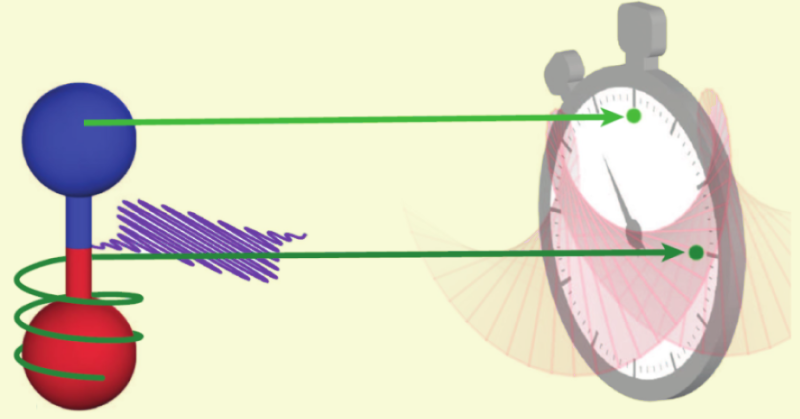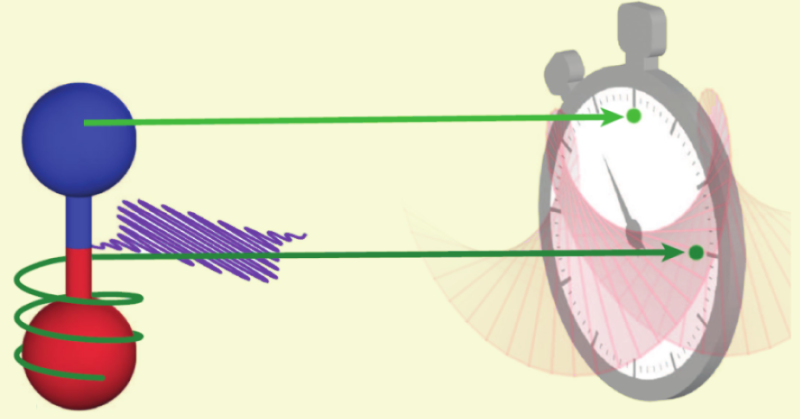Clocking Electrons During Photoionization
When a sufficiently energetic photon hits an atom, it ousts one of the atom’s inner electrons. Belying how the ejection is depicted in textbooks, it isn’t instantaneous. Not only does the fleeing electron still feel the tug of the positively charged nucleus, but it can also be transiently trapped in one of several resonant states. Now Taran Driver of Stanford University and his colleagues have measured how long it takes for a photoionized electron to be ejected from an oxygen atom [1]. They observe that the typical photoelectron escapes in a matter of a few hundred attoseconds (10−18 s). The exact time delay varies with photon energy in a surprising manner, implying that theoretical models may need to account for all the complex ways that an escaping electron interacts with its atomic environment.
The experiment took place at the Linac Coherent Light Source (LCLS), an x-ray free-electron laser (XFEL) at the SLAC National Accelerator Laboratory in California. Crucial to its success was LCLS’s ability to produce isolated, attosecond pulses of adjustable energy. Also crucial was the use of a second, circularly polarized infrared laser, whose femtosecond (10−15 s) pulses arrived on target at the same time as the ionizing pulse from the XFEL. The rotation of the infrared laser’s electric-field orientation provided the hand of the stopwatch: The longer a photoelectron took to leave its atom, the greater the angular deflection its momentum would acquire from the field.
The two lasers are housed in different buildings more than a kilometer apart. Coordinating their pulses with the required precision of a few attoseconds is challenging, so the researchers used a target—the nitric oxide (NO) molecule—that produces its own “starting-gun” signal to mark the beginning of the ionization process. The energy of the XFEL pulses were tuned to just exceed oxygen’s K edge—that is, the energy needed to eject an electron from oxygen’s inner, 1s shell. This energy was much more than nitrogen’s K edge, so the light from the pulses also liberated an electron from the nitrogen’s inner shell. In comparison to the oxygen’s photoelectron, the nitrogen’s photoelectron escapes in a shorter time—in less than 5 attoseconds (as)—and with a faster velocity, making it, in effect, the starting-gun trigger for measuring the escape time of the oxygen’s photoelectron.
Each laser shot ionized a few thousand randomly oriented NO molecules. After passing through electrostatic lenses, the photoelectrons from the N and O atoms struck a microchannel plate (MCP) detector. Where a single photoelectron landed on the MCP depended on its momentum and the orientation of the NO molecule. Collectively, photoelectrons from N atoms filled out a pair of crescent-moon-shaped zones on the microchannel plate, while the shape made by the electrons from the O atom was more complex, reflecting the effect of the tug of the positively charged nucleus and the resonant trapping. Because the N photoelectrons were speedier, their zones were farther from the plate’s center than the O photoelectrons’ zones. And because the O photoelectrons took longer to escape, their zones were rotated on the plate with respect to the N zones.
At the energy just above the O ionization threshold (543 eV) the average rotation was about 10°, which corresponded in the stopwatch’s frame to a delay of 800 as. As the researchers increased the energy of the ionizing photons, the delay shrank. At the highest energy (565 eV) it reached 150 as. If the attraction of the positively charged nucleus was the only source of retardation, the delay would fall rapidly and smoothly with photon energy. But the measured values traced a curve whose slope changed several times. What’s more, apart from at the lowest energies, the measured delays were significantly higher than those predicted for nucleus-only interactions.
To try to understand the observed behavior, the researchers built a model that incorporates many of the complex interactions that a photoelectron can have with the other electrons in a molecule as it leaves the system. They found that the model could reproduce the central part of the delay curve by adding various states that the electrons, interacting among themselves, could occupy in the NO molecule during photoionization.
Theorist Joachim Burgdörfer of the Technical University of Vienna says that calculating time delays in near-threshold photoemission from molecules is a challenge. To improve these models, he says that theorists will need to do a better accounting of the multiple states—both unbound states as well as resonant states—that are available to a photoionized electron as it escapes from its atom. “I consider this experiment to be a first important step in this direction,” he says.
–Charles Day
Charles Day is a Senior Editor for Physics Magazine.
References
- T. Driver et al., “Attosecond delays in X-ray molecular ionization,” Nature 632, 762 (2024).





